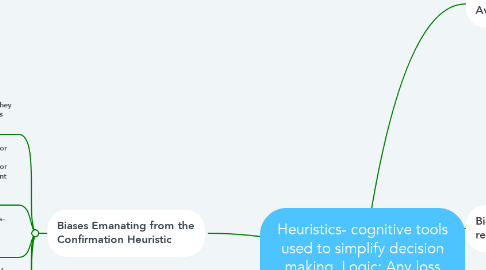
1. Biases Emanating from the Confirmation Heuristic
1.1. Confirmation Trap- individuals seek confirmatory information for what they think is true and fail to search for dis confirmatory evidence.
1.1.1. People tend to seek information that confirms their expectations and hypothesis even when dis confirming/ falsifying information is more useful.
1.2. Anchoring- Individuals make estimates for values based upon initial value (derived from past events, random assignments or other available info) and make insufficient adjustments from that anchor when establishing a final value.
1.2.1. Ex of Anchoring Effects. Hiring organizations are interested in knowing a student's Pre-MBA salaries. These figures often influence the post MBA-offer. (Dis spite that these figures are only marginally relevant to future performance.
1.3. Conjunctive- and disjunctive- events bias- Individuals exhibit a bias towards overestimating the probability of disjunctive events.
1.3.1. Typically occurs with projects that requires multi-stage plannings.
1.4. Overconfidence- being overconfident of the infallibility of their judgement when answering moderately to extreme difficult questions.
1.4.1. Benefit. Often gives you the courage to attempt endeavors that have stretch your abilities. Disadvantage. Can be a barrier to effective professional decision making.
1.5. Hindsight and the curse of knowledge- Often occurs when people look back on their own judgement and those of others. We overestimate what we know beforehand based upon what we later learned.
1.5.1. Knowledge of an outcome increases an individual belief about the degree to which he/she would have predicted that outcome.
2. Biases Emanating from the Availability Heuristic-
2.1. Ease of Recall- Events judge are more easily recalled from memory (vividness/recency) than those events of equal frequency whose instances are less recalled.
2.1.1. Ex. Vivid deaths caused by cars, guns and drugs biases our perception. We underestimate the likelihood of death due to tobacco and poor diet.
2.2. Reliability-individuals base judgement on commonality and easier base strategies. (frequencies are overestimated)
2.2.1. Ex. Estimate the number of of words that have the letter "a" as their third letter. Due to the ease of recalling words starting with "a", we overestimate the latter.
3. Biases Emanating from the representative Heuristic
3.1. Insensitivity to sample Size- people often ignore the issue of sample size which is critical to an accurate assessment of the problem
3.2. Misconception of Chance-a sequence of data generated by a random process will look random even when sequence is too short for those expectations to be statistically valid.
3.2.1. Chance- self correcting process in which a deviation in one direction induces a deviation in the opposite direction to restore equilibrium.
3.3. Regression to the Mean- extreme events/performance tend to regress to the mean on subsequent information.
3.3.1. Ex. Great rookies has less impressive second years. (Regression)
3.4. Conjunction Fallacy- Individuals Falsely judge 2 conjunctions (2 events) are more probable than a more global set of occurrences of which the conjunction is a subset.
3.4.1. Often reflects the degree to which descriptions are representative of the short profile.
3.4.2. occurs when it is assumed that multiple specific conditions are more probable than a single general one.

